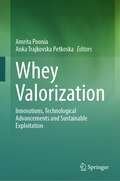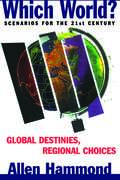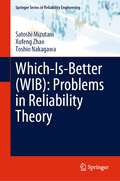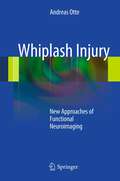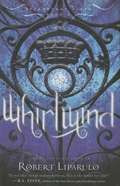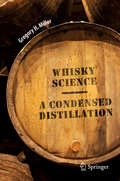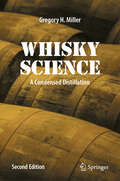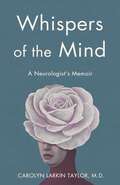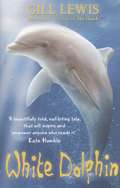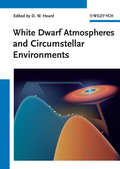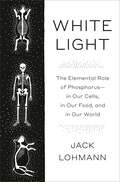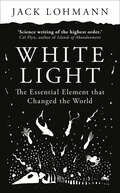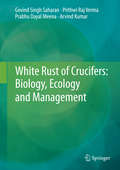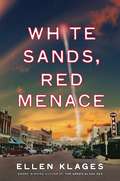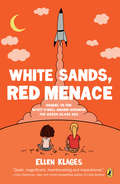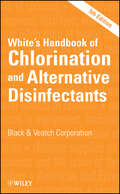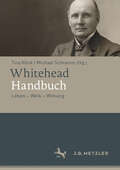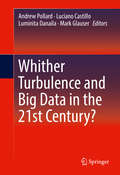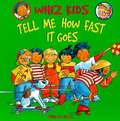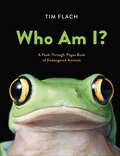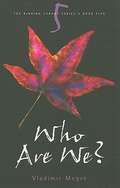- Table View
- List View
Whey Valorization: Innovations, Technological Advancements and Sustainable Exploitation
by Amrita Poonia Anka Trajkovska PetkoskaThis book focuses on the exploitation of whey through the extensive analysis of its molecular composition. Whey can provide various valuable compounds such as lactose, proteins and peptides. The book covers the biotechnological treatments of whey using biochemical and enzymatic treatment and microbial transformation, various high value products such as bioethanol, glycerol, Bioplastics (PLA), bacteriocins, exopolysaccharides, bacterial polysaccharides (PHA, PHB, Xanthan), single cell proteins, probiotics, bioactive peptides, organic acids (lactic, butyric, acetic acid), enzymes and biogas using microbial conversion of whey. The book also covers the use of whey for the preparation of different food products such as whey powder, condensed whey, spreads and various whey-based beverages including fermented beverages. Recent trends, opportunities and challenges in functional carbonated whey-based beverages are also discussed. Unlike the existing literature describing whey utilization, this book focuses on valorization, technological advancement and sustainable biotransformation of whey. The book also deals with membrane processing, sustainable approaches, biotechnological potential, green technologies and production of bioplastics. In addition, the book provides theoretical and practical information to present the various aspects of valorization of whey as a by-product. This book is a need of the hour for its eco-friendly approach. Whey Valorization: Innovations, Technological Advancements and Sustainable Exploitation will be a great resource for researchers, dairy technologists, food technologists, students and professionals working on sustainable and effective utilization of food as well as dairy wastes and by-products.
Which Comes First, Cardio or Weights?
by Alex HutchinsonThere's plenty of conventional wisdom on health and fitness - but how much of it is scientifically sound? The truth is: less than you'd think.In Which Comes First, Cardio or Weights?, physicist and award-winning journalist Alex Hutchinson tackles dozens of commonly held beliefs and looks at just what research science has - and has not - proven to be true: Should I exercise when I'm sick? · Do I get the same workout from the elliptical machine that I get from running? · What role does my brain play in fatigue? · Will running ruin my knees? · To lose weight, is it better to eat less or exercise more? · How should I adapt my workout routine as I get older? · Does it matter what I'm thinking about when I train? · Will drinking coffee help or hinder my performance? · Should I have sex the night before a competition? This myth-busting book covers the full spectrum of exercise science and offers the latest in research from around the globe, as well as helpful diagrams and plenty of practical tips on using proven science to improve fitness, reach weight loss goals, and achieve better competition results.From the Trade Paperback edition.
Which World?: Scenarios For The 21St Century
by Allen HammondIn Which World?, scientist Allen Hammond imaginatively probes the consequences of present social, economic, and environmental trends to construct three possible worlds that could await us in the twenty-first century: Market World, in which economic and human progress is driven by the liberating power of free markets and human initiative; Fortress World, in which unattended social and environmental problems diminish progress, dooming hundreds of millions of humans to lives of rising conflict and violence; and Transformed World, in which human ingenuity and compassion succeed in offering a better life, not just a wealthier one, and in seeking to extend those benefits to all of humanity.
Which-Is-Better (Springer Series in Reliability Engineering)
by Toshio Nakagawa Xufeng Zhao Satoshi MizutaniThis is the first book on the Which-Is-Better (WIB) Problem. These are questions that in daily life include such as “Which is larger, younger and stronger?". The main objective of this book is summarizing WIB Problems in maintenance and reliability theory. Optimal policies of replacement first, last and overtime are derived and compared theoretically and numerically, and WIB policies are determined. Furthermore, the reliability properties of parallel and standby systems are compared, and WIB system is determined. These WIB Problems are applied to shock and damage models and backup and checkpoint models of computer systems.
Whiplash Injury
by Andreas OtteIn the past two decades much has been published on whiplash injury, yet both the confusion regarding the condition and the medicolegal discussion surrounding it have increased. In this scenario, a guide to recent and current international research in the field is more necessary than ever. Especially functional imaging methods - such as single-photon emission tomography, positron emission tomography, functional MRI, and hybrid techniques - have demonstrated a variety of significant brain alterations. This book accordingly offers a critical approach to the challenging interpretation of the new research data obtained using functional neuroimaging in whiplash injury. It covers all aspects, including the imaging tools themselves and the different methods of image analysis. Whiplash Injury: New Methods of Functional Neuroimaging will hopefully help patients, their relatives and friends, physicians, and others to understand this condition as a disease.
Whirlwind (Dreamhouse Kings #5)
by Robert LiparuloDavid, Xander, and Toria King never know where the mysterious portals in their house will take them: past, present, or future. They've still got to find a way to bring their mother back and keep Taskidian from getting them out of the house.
Whisky Science: A Condensed Distillation
by Gregory H. MillerThis is a book about the science behind whisky: its production, its measurement, and its flavor. The main purpose of this book is to review the current state of whisky science in the open literature. The focus is principally on chemistry, which describes molecular structures and their interactions, and chemical engineering which is concerned with realizing chemical processes on an industrial scale. Biochemistry, the branch of chemistry concerned with living things, helps to understand the role of grains, yeast, bacteria, and oak. Thermodynamics, common to chemistry and chemical engineering, describes the energetics of transformation and the state that substances assume when in equilibrium. This book contains a taste of flavor chemistry and of sensory science, which connect the chemistry of a food or beverage to the flavor and pleasure experienced by a consumer. There is also a dusting of history, a social science.
Whisky Science: A Condensed Distillation
by Gregory H. MillerTo be updated with second edition.This is a book about the science behind whisky: its production, its measurement, and its flavor. The main purpose of this book is to review the current state of whisky science in the open literature. The focus is principally on chemistry, which describes molecular structures and their interactions, and chemical engineering which is concerned with realizing chemical processes on an industrial scale. Biochemistry, the branch of chemistry concerned with living things, helps to understand the role of grains, yeast, bacteria, and oak. Thermodynamics, common to chemistry and chemical engineering, describes the energetics of transformation and the state that substances assume when in equilibrium. This book contains a taste of flavor chemistry and of sensory science, which connect the chemistry of a food or beverage to the flavor and pleasure experienced by a consumer. There is also a dusting of history, a social science.
Whispers of the Mind
by Carolyn Larkin TaylorFans of Oliver Sacks and Gabor Maté will be intrigued by this journey into the human brain, full of fascinating stories—both personal and professional—by a neurologist who&’s dedicated her life to understanding the body&’s most complex organ.Do you hear them? The whispers that tell the untold stories of the human mind? In Whispers of the Mind, neurologist Carolyn Larkin Taylor shares stories, both professional and deeply personal, about her journey through the labyrinth of neurology. Composed of essays spanning from medical school to private practice, this memoir reveals Taylor&’s growth as both a healer and a human being and, through vivid and compassionate storytelling, captures the essence of neurology—a field rarely associated with joy but rich in profound rewards. Each essay in Whispers of the Mind chronicles true events that highlight the intricate connection between the brain, heart, and soul and illustrate the resilience of the human spirit, lessons learned from patients, and the beauty found in the courage of those facing neurological challenges. In sharing her stories, Taylor invites readers into the mystique of the human brain, providing a heartfelt glimpse into the life of a neurologist dedicated to understanding and healing the most complex organ of all—the mind.
White Dolphin
by Gill Lewis"The white dolphin is a sign that Mum's out there ..." When they first meet, Kara and Felix can't stand each other. But on discovering an injured dolphin calf on the beach they know they must work together to save it. Now friends, they set out to find the truth behind the disappearance of Kara's mother, and to protect the nearby reef. But powerful people don't want them to succeed. And with the odds stacked against them, how can Kara and Felix make their voices heard?
White Dwarf Atmospheres and Circumstellar Environments
by D. W. HoardWritten by selected astronomers at the forefront of their fields, this timely and novel book compiles the latest results from research on white dwarf stars, complementing existing literature by focusing on fascinating new developments in our understanding of the atmospheric and circumstellar environments of these stellar remnants. Complete with a thorough refresher on the observational characteristics and physical basis for white dwarf classification, this is a must-have resource for researchers interested in the late stages of stellar evolution, circumstellar dust and nebulae, and the future of our own Solar System.
White Feathers: The Nesting Lives of Tree Swallows
by Bernd HeinrichThe surprising, rich life of tree swallows in nesting season—with Heinrich&’s beautiful illustrations and photographs—by the acclaimed naturalist.Heinrich is sparked one early spring day by a question: Why does a pair of swallows in a nest-box close to his Maine cabin show an unvarying preference for white feathers—not easily available nearby—as nest lining? He notices, too, the extreme aggressiveness of &“his&” swallows toward some other swallows of their own kind. And he wonders, given swallows&’ reputation for feistiness, at the extraordinary tameness and close contact he experiences with his nesting birds. From the author of the beloved books Ravens in Winter and A Naturalist at Large, this richly engaging view of the lives of wild birds, as always with Heinrich, yields &“marvelous, mind-altering&” insight and discoveries. —Los Angeles Times
White Holes
by Carlo RovelliA mesmerizing trip to the strange world of white holes from the bestselling author of Seven Brief Lessons on Physics and The Order of TimeLet us journey, with beloved physicist Carlo Rovelli, into the heart of a black hole. We slip beyond its horizon and tumble down this crack in the universe. As we plunge, we see geometry fold. Time and space pull and stretch. And finally, at the black hole&’s core, space and time dissolve, and a white hole is born. Rovelli has dedicated his career to uniting the time-warping ideas of general relativity and the perplexing uncertainties of quantum mechanics. In White Holes, he reveals the mind of a scientist at work. He traces the ongoing adventure of his own cutting-edge research, investigating whether all black holes could eventually turn into white holes, equally compact objects in which the arrow of time is reversed.Rovelli writes just as compellingly about the work of a scientist as he does the marvels of the universe. He shares the fear, uncertainty, and frequent disappointment of exploring hypotheses and unknown worlds, and the delight of chasing new ideas to unexpected conclusions. Guiding us beyond the horizon, he invites us to experience the fever and the disquiet of science—and the strange and startling life of a white hole.
White Light Emitting Materials: Illuminating Brilliance (Progress in Optical Science and Photonics #31)
by Manish Kumar Prashant KumarThis book offers an in-depth exploration of the rapidly evolving field of luminescent materials that hold the key to energy-efficient lighting and advanced display technologies. This book delves into the synthesis, characterization, and application of white light-emitting materials, ranging from organic and inorganic compounds to cutting-edge nanomaterials like quantum dots and carbon-based nanostructures. Through comprehensive discussions on the underlying photophysical mechanisms and emission properties, this volume provides valuable insights into the science driving innovation in solid-state lighting and optoelectronics. This book delivers essential knowledge on how these materials are shaping the future of sustainable and high-performance lighting, providing a good read for researchers, materials scientists, or industry professionals.
White Light: The Elemental Role of Phosphorus-in Our Cells, in Our Food, and in Our World
by Jack Lohmann"At once lyrical and exacting, clear-sighted and deeply informed—a beautiful book." —Elizabeth Kolbert, author of Under a White SkyA profound and poetic reflection on the cyclical nature of life, what happens when we break that cycle, and how to repair it—told through the fate of phosphorus&“There would be no life without constant death.&” So begins Jack Lohmann&’s remarkable debut, White Light, a mesmerizing swirl of ecology, geology, chemistry, history, agricultural science, investigative reporting, and the poetry of the natural world. Wherever life has roamed, its record is left in the sediment; over centuries, that dead matter is compacted into rock; and in that rock is phosphate—one phosphorus atom bonded to four oxygen atoms—life preserved in death, with all its surging force. In 1842, when the naturalist John Stevens Henslow, Darwin&’s beloved botany professor, discovered the potential of that rock as a fertilizer, little did he know his countrymen would soon be grinding up the bones of dead soldiers and mummified Egyptian cats to exploit their phosphate content. Little did he know he&’d spawn a global mining industry that would change our diets, our lifestyles, and the face of the planet.Lohmann guides us from Henslow&’s Suffolk, where the phosphate fertilizer industry took root, to Bone Valley in Central Florida, where it has boomed alongside big ag—leaving wreckage like the Piney Point disaster in its wake—to far-flung Nauru, an island stripped of its life force by the ravenous young industry. We sift through the earth&’s geological layers and eras, speak in depth with experts and locals, and explore our past relationship with sustainable farming—including in seventeenth-century Japan, when one could pay rent with their excrement—before we started wasting just as much phosphate as we mine. Sui generis, filled with passion and rigorous reporting, White Light invites us to renew our broken relationship not just with the earth but with our own death—and the life it brings after us.
White Light: The Essential Element that Changed the World
by Jack Lohmann&‘White Light is a conscience-driven tour de force.' Pico Iyer The most important element you never think about – uncover the secret life of phosphorus Phosphorus is the keystone of life. Without it, cells cannot divide and plants cannot photosynthesise. Highly reactive, it is seldom found in its elemental form – but, when pure white phosphorus is exposed to air, it emits a ghostly white light. In 1842, Darwin&’s beloved botany professor, Reverend John Stevens Henslow, discovered the miraculous potential of phosphorus as a fertilizer. He hardly imagined that his countrymen would soon be grinding the bones of dead soldiers and mummified Egyptian cats to fertilise farms. Nor that his discovery would spawn a global mining industry, changing diets, lifestyle and the face of the planet forever. Journeying across the flat expanses of Henslow&’s Suffolk to far-flung Nauru, an island stripped of its life force by this ravenous young industry, Lohmann sifts through the Earth&’s geological layers and eras, exploring our strained relationship with a life-giving element. Bold, lyrical, genre-defying, White Light invites us to renew our broken relationship not just with the earth but with our own death – and the life it brings after us. *** 'An effervescent – or I should say phosphorescent – debut from a talented young science writer.' Steve Brusatte, bestselling author of The Rise and Fall of the Dinosaurs 'An eerie exploration of a strange and surprising element, and a plangent warning of a looming environmental crisis that needs our attention. Science writing of the highest order.' Cal Flyn, author of Islands of Abandonment 'In this deft and radiant book, Jack Lohmann has achieved something quite rare: a work that is scientifically precise yet ethically expansive.' Rob Nixon, author of Slow Violence
White Rust of Crucifers: Biology, Ecology and Management
by Arvind Kumar Govind Singh Saharan Prabhu Dayal Meena Prithwi Raj VermaWhite rust caused by the fungus Albugo is the most devastating disease known to occur in more than 50 countries and infects about 400 plant species belonging to 31 families worldwide including important vegetable crucifers, oil yielding Brassicas, ornamental plants and numerous weeds. This book on "White Rust" deals with the aspects on "the disease" and "the pathogen" is vividly illustrated for stimulating, effective and easy reading and understanding. We are sure that this comprehensive treatise on "white rust" will be of immense use to the researchers, teachers, students and all others who are interested in the diagnosis and management of white rust diseases of crops worldwide.
White Sands, Red Menace
by Ellen KlagesIt is 1946, and the events of The Green Glass Seahave changed the world and Dewey Kerrigan's life. She's now living near the White Sands Missile Range in New Mexico with the Gordon family. Dr. Gordon is working on rockets that will someday go to the moon; Mrs. Gordon is working on stopping the Bomb. Meanwhile, Dewey and her sister, Suze, share secrets, art, and science as they adjust to high school in an isolated desert town. Then, like a different kind of dropped bomb, Dewey's long-lost mother, Rita Gallucci, reappears in their lives. And she wants to take her daughter away.
White Sands, Red Menace (The Gordon Family Saga #2)
by Ellen KlagesIt is 1946. World War II is over?ended by the atomic bomb that Dewey Kerrigan?s and Suze Gordon?s scientist parents helped build. Dewey?s been living with the Gordons since before the war?s end, before her father died, moving south with them to Alamogordo, New Mexico. At the White Sands Missile Range, Phil Gordon is working on rockets that will someday go to the moon; at home, Terry Gordon is part of the scientists? movement against the Bomb. Dewey and Suze have conflicts of their own. Where does a girl who likes physics and math fit in? How do you know the right time to speak up and the right time to keep your head down? And, most important of all: What defines a family?
White's Handbook of Chlorination and Alternative Disinfectants
by Black & Veatch CorporationNew edition covers the latest practices, regulations, and alternative disinfectantsSince the publication of the Fourth Edition of White's Handbook of Chlorination and Alternative Disinfectants more than ten years ago, the water industry has made substantial advances in their understanding and application of chlorine, hypochlorite, and alternative disinfectants for water and wastewater treatment. This Fifth Edition, with its extensive updates and revisions, reflects the current state of the science as well as the latest practices.Balancing theory with practice, the Fifth Edition covers such important topics as:Advances in the use of UV and ozone as disinfectantsAlternative disinfectants such as chlorine dioxide, iodine, and bromine-related productsAdvanced oxidation processes for drinking water and wastewater treatmentNew developments and information for the production and handling of chlorineLatest regulations governing the use of different disinfectantsFor each disinfectant, the book explains its chemistry, effectiveness, dosing, equipment, and system design requirements. Moreover, the advantages and disadvantages of each disinfectant are clearly set forth. References at the end of each chapter guide readers to the primary literature for further investigation.Authored and reviewed by leading experts in the field of water and wastewater treatment, this Fifth Edition remains an ideal reference for utilities, regulators, engineers, and plant operators who need current information on the disinfection of potable water, wastewater, industrial water, and swimming pools.
Whitehead-Handbuch: Leben – Werk – Wirkung
by Michael Schramm Tina RöckAlfred North Whitehead, einer der kreativsten Denker des 20. Jahrhunderts, legte mit seiner Prozessphilosophie den Grundstein für eine dynamische Sicht auf Wirklichkeit und Erkenntnis. Dieses Handbuch erschließt die historischen und systematischen Grundlagen seiner Philosophie, die von Logik und Metaphysik über Wissenschaftstheorie bis hin zu Kultur- und Erziehungsphilosophie reicht. Neben einer Einführung in Leben und Werk Whiteheads werden zentrale Begriffe wie „Prozess&“, „Organismus&“ und „Ereignis&“ präzise erläutert und in philosophiegeschichtliche Kontexte eingebettet. Ein besonderer Schwerpunkt liegt auf der vielfältigen Rezeption seines Denkens in Philosophie, Naturwissenschaften und Theologie. Das Handbuch bietet Studierenden, Forschenden und Interessierten eine fundierte Grundlage, um Whiteheads Ideen besser zu verstehen und in aktuelle Debatten einzubringen.
Whither Turbulence and Big Data in the 21st Century?
by Andrew Pollard Luciano Castillo Luminita Danaila Mark GlauserThis volume provides a snapshot of the current and future trends in turbulence research across a range of disciplines. It provides an overview of the key challenges that face scientific and engineering communities in the context of huge databases of turbulence information currently being generated, yet poorly mined. These challenges include coherent structures and their control, wall turbulence and control, multi-scale turbulence, the impact of turbulence on energy generation and turbulence data manipulation strategies. The motivation for this volume is to assist the reader to make physical sense of these data deluges so as to inform both the research community as well as to advance practical outcomes from what is learned. Outcomes presented in this collection provide industry with information that impacts their activities, such as minimizing impact of wind farms, opportunities for understanding large scale wind events and large eddy simulation of the hydrodynamics of bays and lakes thereby increasing energy efficiencies, and minimizing emissions and noise from jet engines. Elucidates established, contemporary, and novel aspects of fluid turbulence - a ubiquitous yet poorly understood phenomena; Explores computer simulation of turbulence in the context of the emerging, unprecedented profusion of experimental data,which will need to be stewarded and archived; Examines a compendium of problems and issues that investigators can use to help formulate new promising research ideas; Makes the case for why funding agencies and scientists around the world need to lead a global effort to establish and steward large stores of turbulence data, rather than leaving them to individual researchers.
Whiz Kids: Tell Me How Fast It Goes
by Shirley Willis Betty Root Peter LaffertyMeant for kids, this book discusses simple facts about movement and speed in a clear and concise way.
Who Am I?: A Peek-Through-Pages Book of Endangered Animals
by Tim FlachWho is that peeking through the page? Is it a giant panda munching on bamboo? Or perhaps a yellow-eyed tree frog hiding in a tropical forest? Who Am I? uses clever riddles and stunning images by esteemed photographer Tim Flach (taken from his Abrams adult book Endangered) to introduce ten vital species-at-risk to readers. With its engaging and timely message, this beautifully crafted picture book is perfect for the youngest animal enthusiasts.
Who Are We? (The Ringing Cedars Series #5)
by Vladimir Megré John Woodsworth Leonid SharashkinThe Ringing Cedars Series is creating a wave of excitement that is sweeping the globe with positive, life-transforming messages of pure love energy from the beautiful Anastasia.
